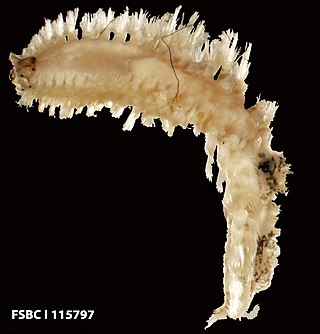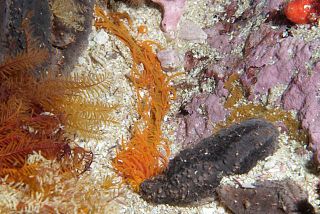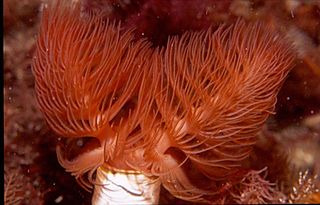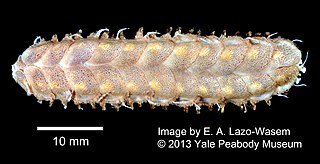
The list of polychaete worms of South Africa is a list of species that form a part of the class Polychaeta (Phylum Annelida) fauna of South Africa. The list follows the SANBI listing.
Contents
- Amphinomida
- Amphinomidae
- Euphrosinidae
- Echiuroidea
- Echiuridae
- Eunicida
- Dorvilleidae
- Eunicidae
- Lumbrineridae
- Oenonidae
- Onuphidae
- Phyllodocida
- Acoetidae
- Alciopidae
- Aphroditidae
- Chrysopetalidae
- Eulepethidae
- Glyceridae
- Goniadidae
- Hesionidae
- Iospilidae
- Lopadorrhynchidae
- Nereidae
- Paralacydonidae
- Pholoidae
- Phyllodocidae
- Pilargidae
- Polynoidae
- Pontodoridae
- Sigalionidae
- Sphaerodoridae
- Syllidae
- Tomopteridae
- Typhloscolecidae
- Nephtyidae
- Sabellida
- Fabriciidae
- Oweniidae
- Sabellariidae
- Sabellidae
- Serpulidae
- Spionida
- Chaetopteridae
- Magelonidae
- Spionidae
- Poecilochaetidae
- Terebellida
- Ampharetidae
- Cirratulidae
- Flabelligeridae
- Pectinariidae
- Sternaspidae
- Terebellidae
- Trichobranchidae
- Scolecida
- Arenicolidae
- Capitellidae
- Cossuridae
- Maldanidae
- Opheliidae
- Orbiniidae
- Paraonidae
- Scalibregmatidae
- Notes
- References
Polychaeta ( /ˌpɒlɪˈkiːtə/ ) is a paraphyletic class of generally marine annelid worms, commonly called bristle worms or polychaetes ( /ˈpɒlɪˌkiːts/ ). Each body segment has a pair of fleshy protrusions called parapodia that bear many bristles, called chaetae, which are made of chitin. More than 10,000 species are described in this class. Common representatives include the lugworm (Arenicola marina) and the sandworm or clam worm Alitta.
Polychaetes as a class are robust and widespread, with species that live in the coldest ocean temperatures of the abyssal plain, to forms which tolerate the extremely high temperatures near hydrothermal vents. Polychaetes occur throughout the Earth's oceans at all depths, from forms that live as plankton near the surface, to a 2- to 3-cm specimen (still unclassified) observed by the robot ocean probe Nereus at the bottom of the Challenger Deep, the deepest known spot in the Earth's oceans. Only 168 species (less than 2% of all polychaetes) are known from fresh waters. ( Full article... )








